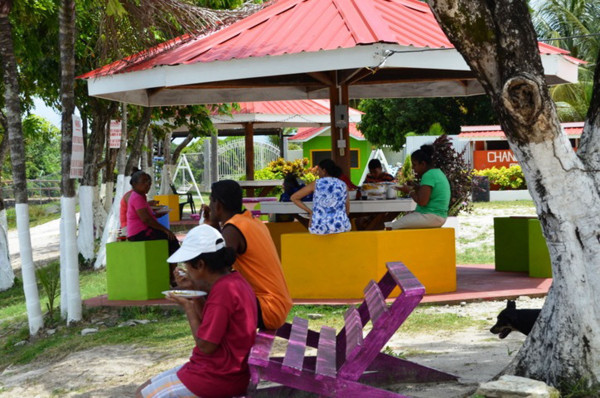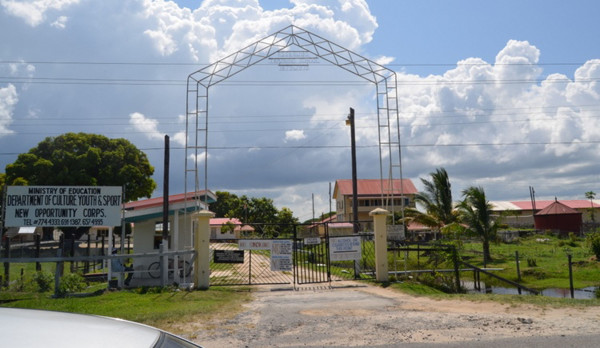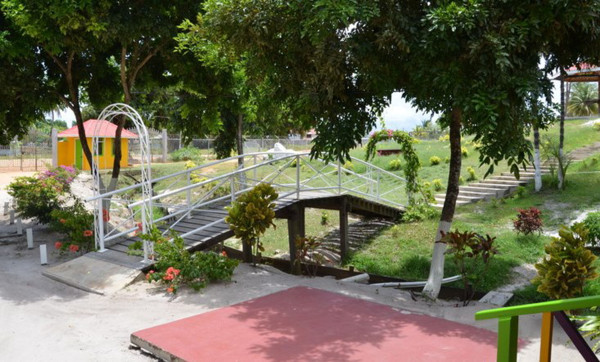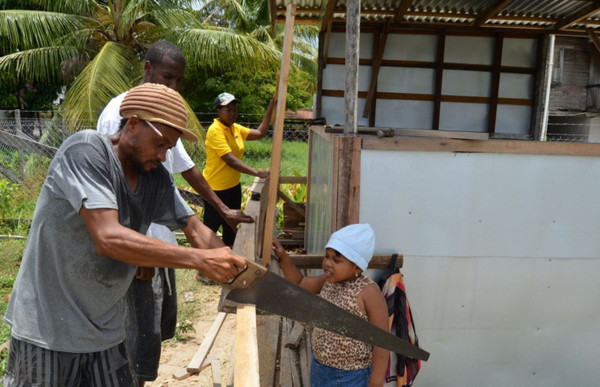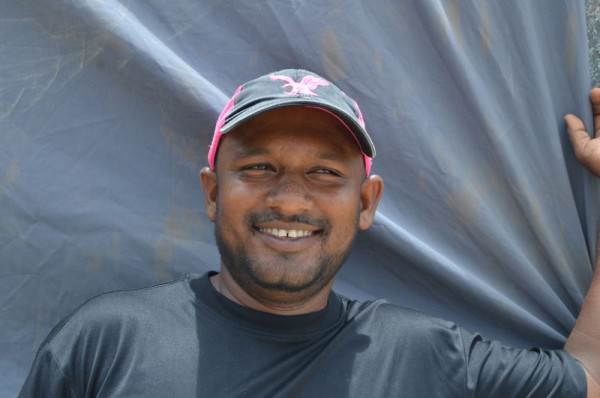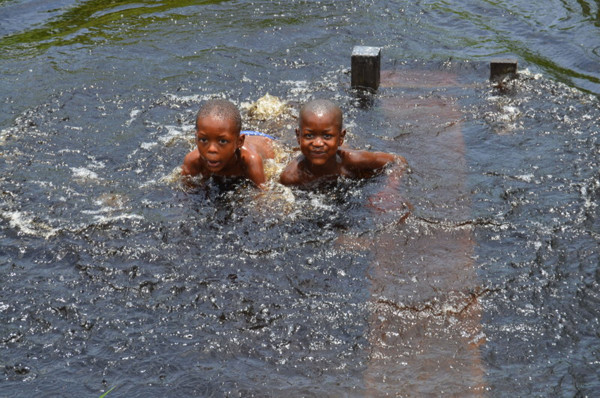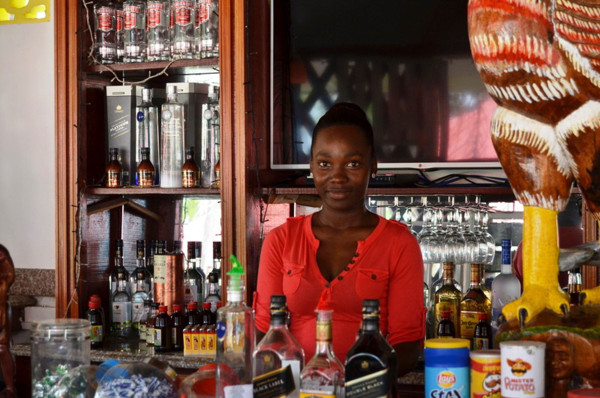Onderneeming on the Essequibo Coast is well known as the home of the New Opportunity Corps (NOC), the institution that houses minors who have been in trouble with the law, but it is gaining more attention now since the establishment of the Rooster Resort and Fun Park.

The resort is popular with residents of the Essequibo Coast and Islands. On a Saturday morning when we visited, one family was there on a picnic.
A staff member of the resort, Tiffany Benn, told The World Beyond Georgetown that the place is crowded on Sundays, when persons have more time for fun, relaxation and entertainment.
There is another resort in the village at the Ituribisi Lake, commonly known as ‘Hot and Cold Lake.’
From a population of about 150, the village has grown to about 800 residents. This was following the establishment of the Little Red Village in 2009 by the Food for the Poor organisation in collaboration with the Roetheli family of the USA.
The bushy area, which already had 15 houses, was cleared to accommodate100 more in order for residents who were living in small shacks to have a better standard of living. They were drawn from poor communities like the Pomeroon and Capoey
Because of their circumstances, villagers purchased house lots, which measure 50 ft by 100 ft, from government at a reduced cost of $66,000. The Little Red Village, which is found in Sandpit Road, also has a school, a health centre, a community centre and a shop.
In general though, the children of Onderneeming attend the primary school in the village and later the secondary schools nearby, including Abram Zuil and Anna Regina.
Residents described the village as “cool, quiet and peaceful” and one even said it is unique, referring to neighbours looking out for each other.
Residents access the market at Suddie and seek health care at the Suddie Hospital located in the next village. On Saturdays those who need health care would attend the private clinic of Dr. Singh, who resides in Georgetown and works at the Georgetown Public Hospital, but had served at the Suddie Hospital for a number of years.
Cook shop
Close to Dr Singh’s clinic in the other section, Leron Patterson was renovating a stall to open a cook shop. His wife, Shenella was helping him as their young daughter, Ronella, looked on.
Leron worked as a miner in the interior but returned home to establish his business because “mining is not like before; the bush get stiff.”
His wife and her mother, who gained her cooking skills at the Carnegie School of Home Economics, would be preparing delicious delicacies for the snackette. In fact, the couple started out selling “from a small table.”
This newspaper also caught up with Wavell David who is engaged in gold mining. He also mentioned that the business got “rough” after the gold price dropped.
Sherwin Pearce was at his home looking out from his veranda as we passed his street.
We motioned to him to come down and he called us in from the scorching sun. “The dogs won’t bite,” he told us as we entered hesitantly.
He has been employed with Barama, a logging company in the Buck Hall Backdam in Essequibo since 2005.
The backdam is accessed through the Sandpit Road and takes one and a half days travelling to get there via trucks and all-terrain vehicles.
The road also provides the entrance to “all the other backdams in Linden, Berbice and other areas,” for gold mining, forestry the rock stone quarry, and as the name suggests, the sandpit.
Though life in the interior can be rough, Sherwin prefers to work there and is always “glad to get away from the road because you don’t make money out here.”
The village has a ‘white sand service’ that was established by Bhojnarine Narine over three years ago.
Narine has used a plot of land at the corner of the street to stockpile the sand that he fetches out from Sandpit. It is sold mostly for construction purposes, at a cost of $8,000 per load in nearby communities, the price ranges from $10,000 to $18,000 for other areas depending on the distance.
Rooster Resort and Fun Park
Apart from going kayaking, pedal boating and swimming in the creek, patrons at Rooster Resort can also enjoy a game of cricket on the ball field located on a sand hill and accessed by a concrete stairway.
Cricket matches would also be organised on the field, through sponsorship by the owner, Ramesh Ramotar.
There is a fee of $400 for entering the resort and while the parking is free from Monday to Saturday, it costs $1,000 on Sundays.
Patrons are also treated to concerts and live shows at times and with barbecues which cost $1,000.
Decorated with beautiful fresh plants, the resort has nine colourful benabs, concrete tables with seats and wooden benches close to the water, two ‘kissing bridges,’ swings and slides, washrooms and changing rooms.
Sitting close to the canal along the Sandpit Road, the resort can be spotted from a distance via a four-seater plane that the owner uses as a showpiece. The plane is mounted on a platform and patrons can go and take photos and have a view of the area.
The resort was opened in July of this year and Tiffany who resides at Sandpit started working there since then as a bartender.
The bar is situated close to the entrance and next to it is the kitchen where another worker, Julie, prepares the fish or chicken with chips daily.
Educator
Sherwin’s mother, Acklima Pearce, an educator, has nearly 40 years’ experience in the profession, which she enjoys a lot.
She attended St John’s Anglican school and started teaching there in 1975. She subsequently wrote the pupil’s teachers’ exam before successfully completing studies at the Cyril Potter College of Education.
She was sent to Fisher Primary School and in 1985 was transferred to Riverstown Primary. In 1990 she was transferred to the Johanna Cecelia Community High where she taught Food and Nutrition, Homes Economics and Home Management.
In 2005, Pearce, well known as Ms Dolly was sent to Aurora Secondary as head of department for the Allied Arts Unit.
At the time the school had no head teacher and was functioning only with a senior master and senior mistress so she immediately performed duties as acting head.
A few months later she was appointed deputy head and then headmistress of the school, which also housed a primary department.
The shortage of space resulted in the government constructing a state-of-the-art school at Pomona for the secondary students.
Pearce retired in December 2013 but because of her love for the profession she took up the challenge to impart her skills at the New Campbellville Secondary.
She deals with the transition students who were not placed at secondary schools at the Grade Six assessment.
With the individual teaching she feels a sense of satisfaction to “see them grow from where they were – not being able to write their names and read” – to doing a lot more than that within a year.
An active woman, she invests further in the lives of young people through teaching at Sunday School and her involvement in the Youth Friendly Space attached to the United Nations Populated Fund.
She also promotes reproductive health and the rights and responsibilities of young people.
Pearce who has another son, Shane, raised and educated her children single-handedly and engaged in small businesses to maintain Shane at the University of Guyana (UG).
She recalled selling fish and chicken at home after school and at the Suddie market and noted that, “Although I was the head teacher it did not make me a lesser person.”
She also served as a lecturer at the Institute of Distance and Continuing Education through UG in the areas of cakes and pastry making, clothing and textile, fabric designing, catering and cake decorating.
These courses, she said, “helped to empower the early school leavers and drop out students to have a skill so they could have earned a living.”
Early in her career she was a member of the Guyana National Service as a teacher officer in the YBNCC, which required that she cut cane whenever the sugar workers went on strike.
She said too that as “a believer of Christ, I attend prayer meeting [on] Monday and Tuesday nights, deliverance on Wednesday nights and service every Sunday.”
New Opportunity Corps
The NOC is a correctional facility is intended to educate and reform the occupants so they can fit back into society.
The playground at the facility can used by members of the community and for school sports.
Adolescent offenders and ‘wanderers’ are sentenced to between one to three years at the facility where they undergo skills training including, electrical installation, handicraft, joinery and information technology. They also get the opportunity to participate in football, cricket, cycling and swimming.
According to the Ministry of Education website, the NOC offers psychosocial support to the youth in order to help them improve their self-esteem and self-worth.
